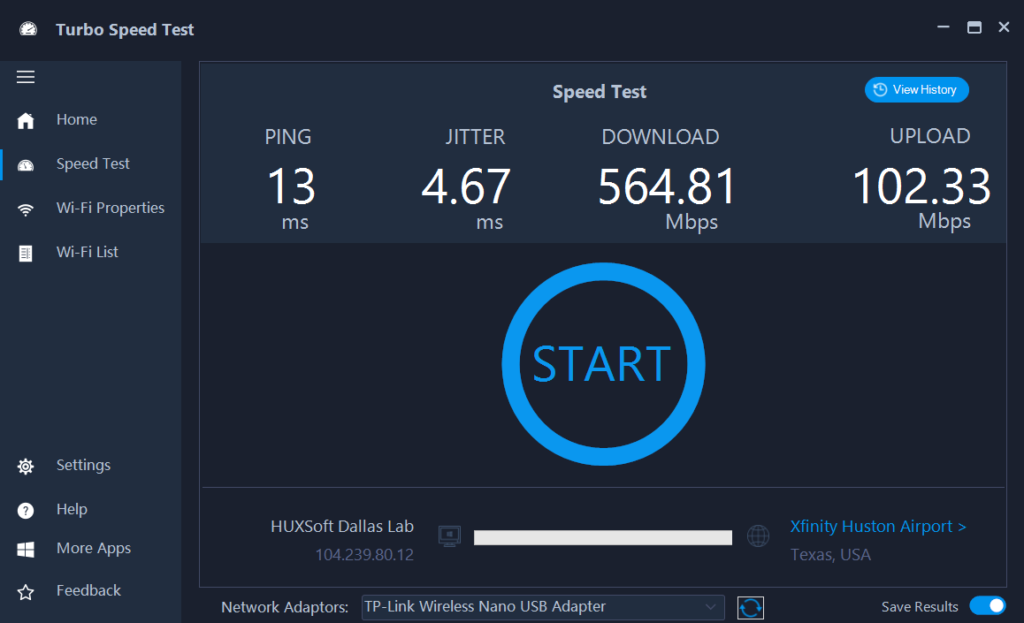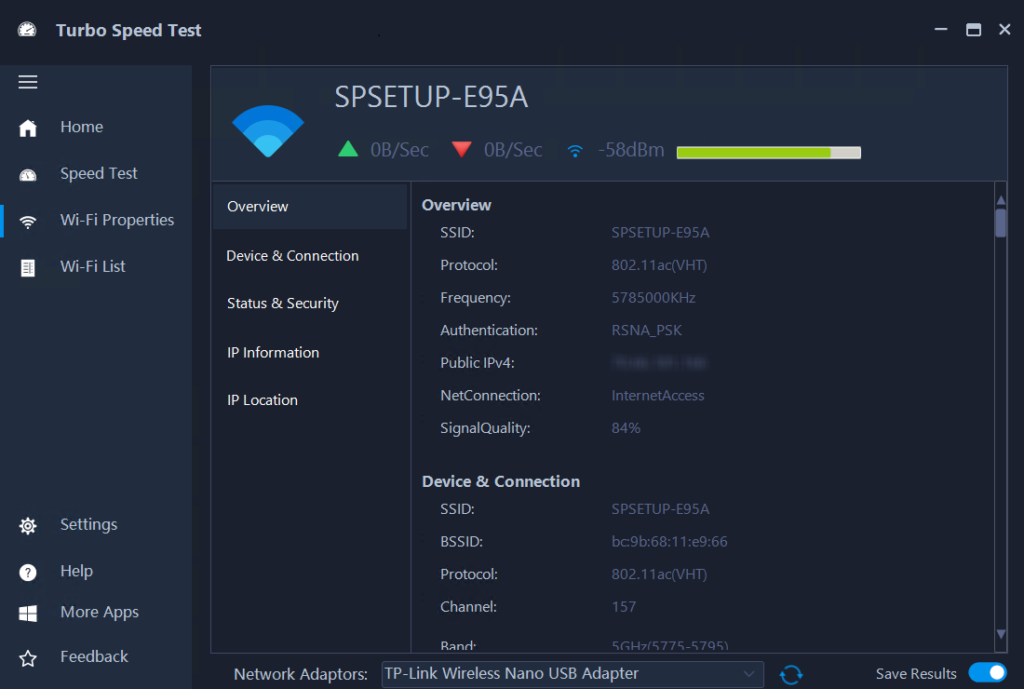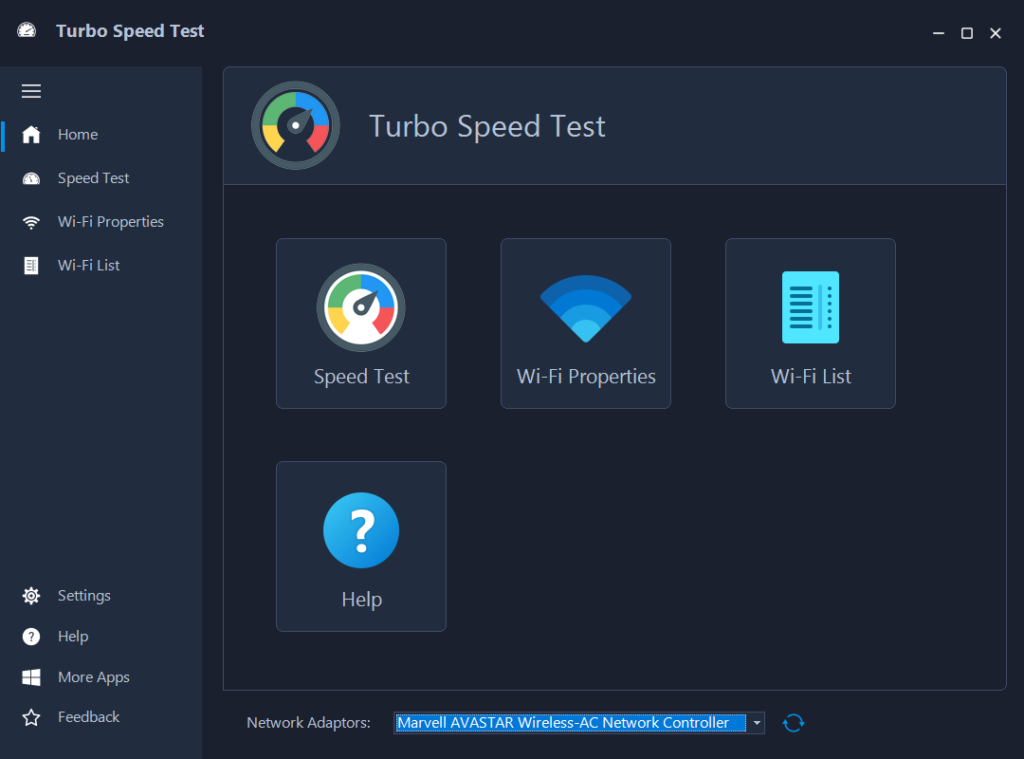Turbo Speed Test - Product Help File
Turbo Speed Test is an easy-to-use app that helps you evaluate and enhance your Wi-Fi performance. It offers features such as a detailed speed test to measure ping, jitter, download, and upload speeds, giving you a clear view of your network’s efficiency. Additionally, it provides in-depth Wi-Fi properties, including SSID, BSSID, protocol, and signal strength, along with a list of nearby Wi-Fi networks with key details like signal strength and frequency. Turbo Speed Test ensures you have the insights needed for optimal Wi-Fi connectivity.
– Advertisement –
Key Features:
Speed Test: Evaluate the bandwidth and performance of your WiFi connection with a built-in speed test. Measure ping, jitter, download, and upload speeds to ensure optimal performance.
WiFi Properties: Gain in-depth knowledge about your WiFi network with detailed attributes and properties of your current WiFi adapter. Explore information such as SSID, BSSID, protocol, channel, bandwidth, signal quality, and more.
WiFi Network List: View and analyze a list of available WiFi networks in your vicinity. Identify signal strength, band frequency, channel information, and other essential details to make informed decisions about network selection.
Product support
Have questions regarding the functions of the product, license acquisition, or want to provide product feedback? We love to hear from you:
- Email our support team: [email protected]
- If you have encountered an issue while using the app, explain the nature of the problem, with steps to follow in order to reproduce it
Our knowledgeable and friendly support team member will get back to you in a timely manner.
Launch the application
- Click the Windows Start button

- Type “Turbo Speed Test”
- Identify the matching application entry in search result with this icon

- Click the application entry to launch the application
Please note: an Internet connection is required to use the main functions of the app.
Main Window
The main application window serves as the central hub for accessing all the core features It provides direct access to the following features:
- Speed Test: Measure the speed of your Wi-Fi connection to determine its performance. This feature allows you to assess both the download and upload speeds of your network.
- Wi-Fi Properties: View detailed information about your current Wi-Fi connection. This feature provides essential details such as signal strength, network name (SSID), security type, and more.
- Wi-Fi List: Explore a comprehensive list of available Wi-Fi networks in your vicinity. This feature allows you to identify nearby networks, including their signal strength, security protocols, and other relevant information.
Functions of each feature will be explained in the sections below.
Speed Test
The Speed Test module measures your Wi-Fi bandwidth and performance through the following core criteria:
Ping: Ping measures the response time between your device and a server. It calculates the time taken for a small packet of data to travel from your device to the server and back. Lower ping values indicate better responsiveness and less latency in your network connection.
Jitter: Jitter refers to the variation in the delay of data packets during transmission. It measures the consistency of your network’s latency. A lower jitter value signifies a more stable and consistent connection, which is crucial for applications like online gaming or real-time communication.
Download speed: Download speed measures the rate at which data can be downloaded from the internet to your device. It determines how quickly you can access and retrieve content such as web pages, files, or streaming media. Higher download speeds result in faster data retrieval.
Upload speed: Upload speed measures the rate at which data can be uploaded from your device to the internet. It determines how quickly you can send files, videos, or other data to online servers or other devices. Higher upload speeds are essential for activities like video conferencing, cloud backups, or sharing large files.

These criteria provide insights into different aspects of your Wi-Fi performance. Understanding these measurements can help you assess the quality and stability of your internet connection.
Start testing
The Speed Test module is preconfigured with common default settings for your convenience, allowing you to begin testing immediately. To perform a speed test, simply click the ‘Start’ button located in the center of the window.
Choose a speed test server
Based on your current geolocation, the app compiles a list of speed test servers within a 100 KM radius approximately. By default, the closest server is selected.
You can also pick a different server by clicking on the label of the current server, which ends with a greater-than-symbol > to show a list of optional speed test server. Select a server from the list, and click OK to set it as the test server.
Save and view test results
Data from each speed test can be saved individually based on your preference, which is set by the Save Results toggle button ![]() , located at the bottom-right corner of the window. Toggle this button on prior to starting a test result in order to log the results.
, located at the bottom-right corner of the window. Toggle this button on prior to starting a test result in order to log the results.
To view all test results logged so far, click the View History button located at the top-right corner of the window.
- To remove all test log entries, click the Clear History button
- To go back to the Speed Test module, click the Left arrow

Multiple Wi-Fi adaptors
In rare but not impossible circumstances, your PC may have multiple Wi-Fi adaptors. Use the Wi-Fi adaptor selection dropdown control located at the bottom of the window to set the active Wi-Fi adaptor for the test.
![]()
Wi-Fi Properties
The “Wi-Fi Properties” module presents users with a comprehensive overview of the attributes and properties of their current Wi-Fi adapter. It offers valuable information in a convenient format, allowing users to quickly access and review key details about their Wi-Fi connection.
The module is divided into several sections.
- The Device & Connection section provides insights into the network’s SSID, BSSID, protocol, channel, band, bandwidth, frequency, network type, and download/upload rates.
- The Status & Security section displays information regarding signal quality, connectivity status, encryption type, authentication type, and runtime.
- The module also offers IP information, including IPv4 and IPv6 details such as IP address, subnet mask, gateway, DHCP server, DNS server, as well as IP location attributes such as continent, country, region, city, zip code, latitude, and longitude.

Quick info
The header area of the “Wi-Fi Properties” module offers a convenient overview of the current status of your Wi-Fi adapter. It includes essential information at a glance, such as the connection status, upload speed, download speed, and signal strength (RSSI).
Devices & Connection
This group focuses on the attributes and properties of your WiFi adaptor and the connection it establishes. It includes information such as the SSID (Service Set Identifier), which is the name of your WiFi network, and the BSSID (Basic Service Set Identifier), which uniquely identifies your wireless access point. You can also view details about the protocol used, the current channel, and the band frequency (2.4 GHz or 5 GHz) of your WiFi network. Additionally, the group provides essential data like the bandwidth, frequency, and network type. It even displays the current download and upload rates, giving you real-time insights into your WiFi connection performance.
Status & Security
In this group, you can access crucial information about the status and security of your WiFi network. It displays the RSSI (Received Signal Strength Indicator), which indicates the signal quality of your WiFi connection. You can also determine whether the network is connectable or not and find out the reason if it’s not connectable. The group provides details about the encryption type and authentication method used by your network, ensuring you have a secure connection. Additionally, you can view the runtime of your WiFi adaptor, giving you insights into its active duration.
IP Information
The IP Information group provides in-depth details about the IP (Internet Protocol) configuration of your WiFi network. You can find information about both IPv4 and IPv6 addresses, subnet masks, gateways, and DNS (Domain Name System) servers. It provides visibility into your network’s IP allocation, allowing you to troubleshoot connectivity issues, set up port forwarding, or configure network services effectively.
IP Location
This group provides geolocation information about your network’s IP address. It offers data such as the continent, country, region, city, postal code, latitude, and longitude associated with the IP address. This information can be useful for various purposes, such as identifying the approximate physical location of your network or understanding the geographical distribution of your users.
Read this blog post to learn detailed information of each attribute in the Wi-Fi Properties module.
Wi-Fi Network List
The Wi-Fi network list module presents a compilation of available networks in your vicinity that can be detected by your current Wi-Fi adapter. It offers a summary of essential information for each network, including the band frequency, channel ID, and received signal strength indicator (RSSI).

You can also select each network to view more detailed info including: network protocol, bandwidth, frequency, authentication, IP, signal quality, upload/download speed etc.
The Display Options
The network list module provides options for customizing the display and sorting of Wi-Fi networks. These options include filtering networks based on their types, such as open, secured, hidden, Wi-Fi direct, or unreachable networks. Additionally, users can choose to filter networks based on their band frequencies, such as 2.4 GHz or 5.0 GHz. Lastly, networks can be sorted based on their signal strength, with options like strong, good, fair, or weak.
Click the “Filter…” link located at the top of the list to view and access the options for displaying the networks:
Types of Wi-Fi networks
Based on their types. Here are the different types of Wi-Fi networks that can be selected:
- Open Network: An open network is a Wi-Fi network that does not require any password or authentication to connect. Users can join these networks without entering any credentials.
- Secured Network: A secured network is a Wi-Fi network that is protected with a password or encryption. Users need to provide the correct authentication credentials to connect to these networks.
- Hidden Network: A hidden network, also known as a closed network, is a Wi-Fi network that does not broadcast its SSID (Service Set Identifier). These networks are not visible in the regular list of available networks, but users can manually connect to them by entering the network name (SSID) and password.
- Wi-Fi Direct: Wi-Fi Direct allows devices to connect directly to each other without the need for a traditional wireless access point. It enables peer-to-peer communication between devices, allowing for file sharing, screen mirroring, or other direct interactions.
- Unreachable Network: An unreachable network refers to a Wi-Fi network that is currently out of range or not accessible by the Wi-Fi adapter. These networks are beyond the reach of the device and cannot be connected to at the present moment.
Band frequencies
Select to show or hide networks of different band frequencies:
- 2.4 GHz
- 5.0 GHz
Signal strength
Choose to show or hide network based their signal strength levels:
- Strong
- Good
- Fair
- Weak
The Sorting Options
The Wi-Fi network list can be sorted based on:
- Name
- Signal strength
- Band
- Channel
You can also toggle the sorting order by toggling the ascending/descending icons ![]()
![]()








